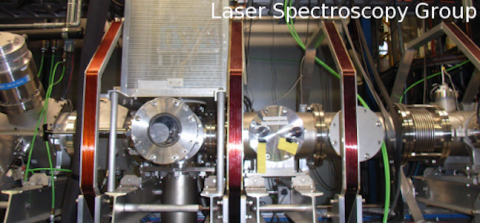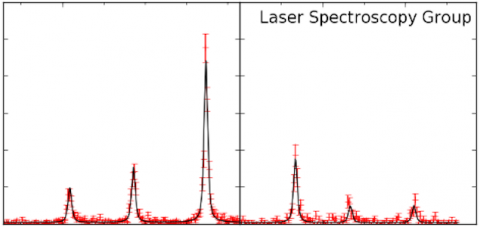

During a recently finished experiment, the laser spectroscopy group at TRIUMF succeeded in measuring the atomic spectra of three light Francium isotopes for the first time. The observations from the experiment have been analysed, and the results will be used to extract fundamental nuclear properties of the isotopes. These final results can then serve as test for nuclear and atomic models.
The classical picture of an atom consists of a small, dense centre called the nucleus which is surrounded by electrons. The interplay between the protons and neutrons within the nucleus and the electrons outside it slighty changes the behaviour of the electrons. This change in energy of the electrons gives rise to the atomic hyperfine structure. The hyperfine structure spectrum of a particular atom is like a fingerprint of an individual person and can be seen using lasers. At TRIUMF, the collinear fast beam laser spectroscopy technique is used to observe these spectra.
Looking in more detail, the hyperfine structure can be regarded as the interaction of the multipole expansion of the nucleus with the respective orders of the electromagnetic field due to the electrons. The term of zeroth order is related to the size of the nucleus. Relative changes in nuclear size between two isotopes arise from differing neutron numbers for different isotopes of the same element. This is seen as a change in the net frequency of the hyperfine structure and is called the isotope shift. The largest contribution to the atomic hyperfine structure is due to the magnetic interaction of the electrons with the magnetisation of the nucleus. In light elements the nucleus may be considered as a point-like pure dipole field. In heavier systems, like francium with 87 protons and around 120 neutrons, this assumption breaks down due to the increase in nuclear size. The hyperfine structure is therefore affected by both the magnetisation radius of the nucleus and its internal magnetic distribution. This change from a pure point-like assumption is today known as the Bohr-Weisskopf effect or hyperfine anomaly and is reflected in the observable atomic spectrum.
Due to its simple atomic structure, francium provides a particularly good laboratory to probe the ratio of the hyperfine parameters related to the nuclear magnetisation for two different atomic states. To obtain a reliable comparison to different nuclear and atomic models, a good knowledge of the nuclear properties and in particular its spin are required. Little is known, however, about the nuclear structure in the neutron-deficient francium region. Therefore the collinear laser spectroscopy collaboration set out to study the fundamental properties of the francium isotopes around the N=118 neutron subshell closure. This provides a first step in the local francium hyperfine anomaly program. Originally started in the late 1990s at the State University of New York in Stony Brook, TRIUMF's research scientist Dr Matthew Pearson brought the project to TRIUMF in 2004 to proceed to more neutron-deficient francium isotopes that had not been studied in this way before.
During an experiment early September 2012, seven nuclear states ranging over four isotopes were studied within three days. Hyperfine spectra of three isotopes were obtained over the course of the first shift of the experiment. Atomic structure permitting, the hyperfine spectra were resolved, potentially allowing the determination of the nuclear spin amongst other fundamental nuclear properties such as the electromagnetic moments.
The success of the group is even more remarkable considering that they had to give up their old laboratory over a year ago to make room for another experiment. The fruitful experiment used their new, only partially finished laser laboratory which was turned into an operational state only six months after obtaining the new location.
Images:
Top: Setup of the collinear laser spectroscopy beamline at TRIUMF
Bottom: Typical observed atomic hyperfine structure spectrum for francium
By Annika Voss, Laser Spectroscopy Group
By Annika Voss, Laser Spectroscopy Group
